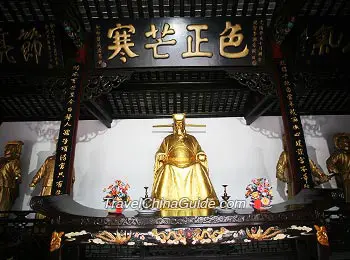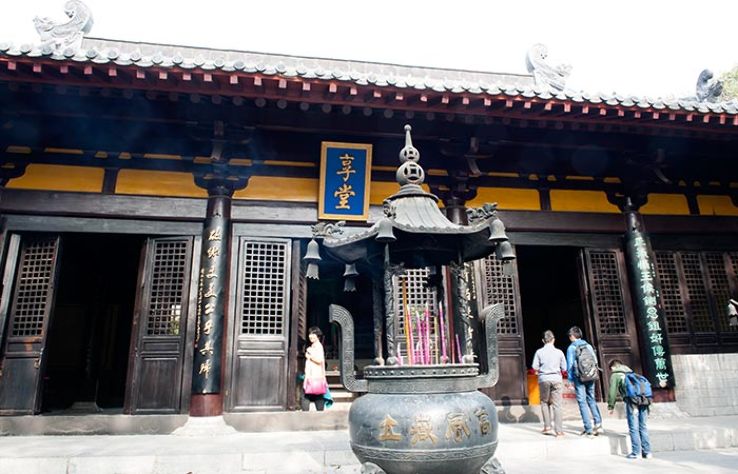Exploring Hefei’s Lord Bao Temple and Historical Significance
Welcome to Hefei, a city brimming with Hefei historical landmarks that offer a deep dive into China cultural history. As you plan your next adventure in China, the Lord Bao Temple stands out as a must-visit destination for travelers, culture enthusiasts, and history buffs alike. This serene site not only pays tribute to the legendary Bao Zheng but also encapsulates the essence of cultural attractions in Hefei, making it a perfect stop on any Hefei travel guide. Here at jusha.travel, we love sharing tips to make your China journey unforgettable, and today, we’ll explore this fascinating landmark to inspire your travels. https://jusha.travel/historical-places-in-china-a-comprehensive-guide-to-ancient-sites-and-cultural-landmarks/ offers more on ancient sites that complement this journey.
Imagine wandering through ancient halls where stories of justice and integrity come alive—it’s an experience that connects you to the rich tapestry of China history travel. Whether you’re drawn to the moral tales of ancient officials or the architectural wonders of old China, the Lord Bao Temple promises an enlightening visit. Let’s uncover its secrets together. https://jusha.travel/top-10-must-visit-cities-in-china-for-2025-adventures/ can help you include Hefei in your broader China itinerary.
Background and Historical Significance

Nestled in the heart of Hefei, the Hefei Lord Bao Temple is a cornerstone of Hefei historical landmarks, dedicated to Bao Zheng, a revered figure from the Northern Song Dynasty (960–1127). Born in 999 AD in what is now Anhui Province, Bao Zheng—affectionately known as “Lord Bao” or “Clear-Sky Bao”—rose to prominence as an incorruptible official who championed justice and fairness. His legendary exploits, including demoting high-ranking officials for corruption, have made him a symbol of integrity in Chinese folklore, inspiring countless operas, TV dramas, and even modern discussions on governance [source: Lord Bao’s Temple – China Tour].
For travelers curious about China cultural history, visiting this temple offers a tangible link to the past. Bao’s story isn’t just history; it’s a living legacy that highlights the importance of ethical leadership in ancient China. One fascinating fact is how his reputation for uprightness influenced legal traditions, where his image is often invoked in courts as a reminder of moral duty. If you’re planning a trip, consider timing your visit during quieter weekdays for a more reflective experience—ideal for those seeking authentic cultural immersion. Here in Hefei, this site exemplifies how cultural attractions in Hefei blend history with everyday life, providing insights into China’s enduring values of honesty and justice. https://jusha.travel/why-xians-terracotta-warriors-are-worth-the-hype/ provides more context on similar historical figures and sites.
As you explore, keep in mind practical tips for your journey: Wear comfortable shoes for walking the temple grounds, and if you’re traveling with family, note that the site’s stories make for great educational tales for children. For more on Bao Zheng’s life, check out detailed accounts [source: 包公祠 The Memorial Temple of Lord Bao].
Development and Architectural Evolution

The evolution of the Hefei Lord Bao Temple mirrors the broader narrative of China cultural history, with its architecture reflecting centuries of reconstruction and cultural reverence. Originally built shortly after Bao Zheng’s death in 1062, the temple has undergone numerous expansions, most notably during the Qing Dynasty (1644–1912). A significant contribution came from Li Hongzhang, a prominent politician, who funded restorations in 1882, blending traditional Chinese design with historical symbolism [source: A tribute to honesty – China Daily].
This site is a prime example of classic Chinese temple layout, featuring a central courtyard surrounded by halls, an incense burner for offerings, and five interconnected main halls that symbolize harmony and balance—elements that any Hefei travel guide would highlight for architecture lovers. The “Incorruption Well” stands out as a unique feature, representing Bao’s unyielding moral purity and serving as a poignant reminder of ethical standards in ancient governance. https://jusha.travel/why-beijings-forbidden-city-is-a-must-see-in-2025/ discusses similar architectural marvels that add to the understanding of this evolution.
For modern travelers, understanding this evolution adds depth to your visit. If you’re into China history travel, appreciate how the temple’s design incorporates feng shui principles, promoting serenity and reflection. Pro tip: Combine your trip with nearby sites like Bao Gong Park for a full day of exploration. During your visit, you might even catch cultural performances or festivals that celebrate Bao’s legacy, offering a taste of local traditions. This integration of history and architecture makes the temple a standout among cultural attractions in Hefei, where past and present coexist seamlessly.
Key Features and Exhibits
Delving deeper into the Hefei Lord Bao Temple, you’ll discover an array of exhibits that bring China cultural history to life, making it one of the top cultural attractions in Hefei. A highlight is the inscription stone, unearthed in 1973 from Bao Zheng’s tomb, which provides a detailed biography and serves as a vital artifact for historical studies [source: Lord Bao’s Temple – China Tour]. Stone inscriptions along the walls narrate tales of his exploits, offering visitors a chance to connect with the era’s storytelling traditions. https://jusha.travel/what-makes-guilins-landscapes-chinas-most-stunning-escape/ offers insights into other cultural stories that echo this.
Modern additions, like the Waxwork Museum of Lord Bao and the Cultural Gallery, use interactive multimedia displays to make history engaging. Imagine seeing lifelike wax figures of Bao in his official robes or watching videos that depict his famous cases—this is where technology meets tradition, appealing to tech-savvy travelers. For instance, the gallery often features augmented reality experiences that let you “witness” historical events, aligning with China’s rapid tech advancements. https://jusha.travel/whats-new-in-chinas-tech-scene-innovations-to-see-in-2025/ can provide more on China’s tech evolution that complements this.
Practical advice for visitors: The temple is open from 8:00 AM to 6:00 PM, with low or no entry fees, making it accessible for budget travelers. If you’re interested in Hefei travel guide essentials, pair this with nearby attractions like the Anhui Provincial Museum for a comprehensive cultural day. An interesting fact? Bao’s stories have influenced contemporary Chinese media, from TV series to films, showing how China history travel continues to shape popular culture. Don’t miss the east and west verandas for peaceful spots to reflect or snap photos.
Cultural Significance and Modern-Day Role

Beyond its physical beauty, the Hefei Lord Bao Temple plays a vital role in China cultural history, serving as a hub for civic education and reflection on themes like justice and governance. Surrounded by Lord Bao Park, which includes features like the Qingfeng Pavilion and Bao’s tomb, this site embodies the moral ideals that have shaped Chinese society for nearly a millennium [source: [2025 Hefei Attraction] Travel Guide for Lord Bao Memorial].
In today’s world, the temple attracts visitors seeking inspiration from Bao’s legacy, from school groups learning about anti-corruption to tourists pondering ethical dilemmas. This makes it a key part of any Hefei travel guide, especially for those interested in how ancient values influence modern China. Cultural insights abound here; for example, during festivals, locals perform traditional operas retelling Bao’s stories, offering a glimpse into China’s rich performing arts. https://jusha.travel/exploring-chinese-festivals-a-guide-to-vibrant-cultural-celebrations-in-china/ can help you align your visit with these events.
For practical travelers, consider visiting in the early morning for fewer crowds and a chance to participate in local customs, like burning incense for good fortune. If you’re a foodie, nearby Hefei streets offer Anhui specialties like stinky tofu or fish head soup—pairing history with culinary adventures, a staple of China history travel. The temple’s tranquil atmosphere also provides a perfect backdrop for meditation, blending cultural exploration with personal wellness.
As we wrap up our journey through the Hefei Lord Bao Temple, it’s clear that this landmark is more than just a site—it’s a gateway to understanding Hefei historical landmarks and the broader narrative of China cultural history. From Bao Zheng’s timeless lessons on integrity to the temple’s stunning architecture and interactive exhibits, your visit will leave you inspired and enriched. Whether you’re planning a deep dive into cultural attractions in Hefei or seeking tips for China history travel, sites like this remind us of the enduring spirit of exploration.
Here at jusha.travel, we’re passionate about guiding you through these incredible experiences. So, what are your thoughts on Lord Bao’s legacy? Share your stories in the comments below, visit jusha.travel for more China feed inspiration, or check out related articles like our Hefei city guide. Let’s keep the adventure going—safe travels!





